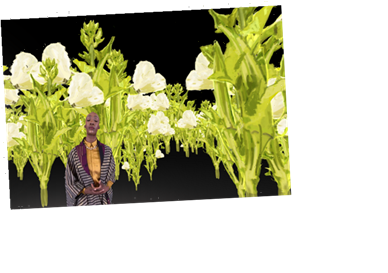Each year, IndieWire partners with MIT’s Open Documentary Lab to offer a deeper look at Sundance’s New Frontiers work. Here, Master’s Candidate Andrea S. Kim highlights the innovative use of browser-based media by Black storytellers, which are still accessible at the links provided in the article.
While the idea of extended reality (XR) may evoke traditions of cyberpunk dystopias, at this year’s Sundance New Frontiers, five Black storytellers were leading a shift to place cultural memory and ancestral knowledge at the center of designing collective futures. “Secret Garden” and “Traveling the Intertitium with Octavia Butler” are exemplary pieces that leverage interactive, browser-based media (WebXR) to challenge our current notions of futurity while also demonstrating the potential for XR when led by Black creators.
“Our stories are algorithms,” artist Stephanie Dinkins suggests in the descriptive text for “Secret Garden, an interactive web experience (available here) and in-person installation that pairs a vibrant 3D landscape with oral histories spanning generations of African American women, including one that is “artificially intelligent.” The piece is an extension of Dinkins’ body of work that creates AI systems programmed and trained by Black and brown voices otherwise underrepresented in our technologies.
Dinkins’ critical interventions come at a much-needed point in the current crisis of racial bias in technology, part of which was publicly exposed last December when leading researcher in AI ethics was fired from Google after the tech giant blocked her research on this very topic.
“The more I work with artificial intelligence, the more I think about our stories, our data, and what we’re feeding ourselves and the systems that sustain us,” said Dinkins at a panel hosted by NEW INC. “I’m thinking of story, and story as guidance.”
“Secret Garden” shares six distinct stories of resilience and revelation — from surviving a slave ship to living on a Black-owned farm in 1920 — and each emphasizes the value of treasuring memory and carrying on knowledge amid histories of trauma and erasure.
When first entering “Secret Garden,” you are confronted with an ensemble of competing voices. From a distance, they are hushed, incomprehensible murmurs where it’s unclear when one voice starts and the other ends. Caught in between fragments, you find yourself confused, perhaps a bit frustrated, yet yearning to figure out the secret. As you spend more time in the garden, walking around or using your keyboard to navigate, you might encounter a distant voice: “We are stronger, more powerful than they know.”
Each of the characters in “Secret Garden” draws you towards them to listen to their stories. Increasingly, you find the individual contours of each voice becoming more clearly defined, yet never disconnected from one another. While one character says, “Remember how papa taught you to get water from the trunk of the Baobab tree and eat its sour fruit,” another recounts, “I remember great mama teaching us to plant yams the way they did in Africa.” These stories unfold side by side, but take place a century apart.
“The metaphor of the garden is truly one that I borrow from my grandmothers and the way they use gardens to cultivate space, to cultivate community, and to cultivate a place for themselves where they could feel whole and share their inner thoughts,” Dinkins said on the panel.
“Secret Garden” is best understood as an effort to create more inclusive showcases of artificial intelligence. Centering the voices of Black women in a culture that has historically silenced them, “Secret Garden” demonstrates how such archives of ancestral knowledge are the starting point from which equitable AI systems should be founded on. Just as AI is missing a history, Dinkins argues through her work, so too is our society’s imagination for the future.
Similarly, “Traveling the Interstitium” revives an Afrofuturist ethos by “creating portals” (channeled by interactive webXR) into the work of five groundbreaking Black artists: Sophia Nahli Allison, idris brewster, Ari Melenciano, Terence Nance, and Dinkins, who all use mixed media methods ranging from video art and web radio to game engines.
This collective traced a genealogy sparked by the late Octavia E. Butler, who stripped science fiction of its usual dystopian backdrops and white, masculine heroes to reimagine the genre in Afrofuturist terms steeped in survival, empathy, and hope.
In Allison’s “Pluto,” you join an intimate meditation with the first astronaut to travel to Pluto. “We are an ever-expanding universe. A living, breathing archive,” she says. In brewster’s “Quantam Summer,” you use your keyboards to navigate an island that emanates with music and joy. Dinkins’ #WhenWordsFail prompts a single question – “What do you need to let go of to move forwards?” — and allows viewers to use their cameras and microphones to submit a response into cyberspace.
In many ways, WebXR provides the perfect medium to approach these stories, especially during our current landscape of virtual programming. Accessible on all browsers yet still visually stunning, these projects offer a glimpse of what is to come for XR. Each piece in “Traveling the Interstitium” is conceptually tied to Butler’s concept of an “interstitium” as a liminal space of emergent possibilities. As a curated gallery within New Frontiers, it makes its message clear. We are witnessing the active construction of a new medium, with an imagination unconstrained by colonial and racist legacies in media.
As the AI in “Secret Garden” articulates: “The unencumbered, undistracted Black mind is a wellspring of possibility.” These leaders in immersive storytelling are paving the way for a new era of virtual storytelling, one that looks critically to the past to move forwards.
Andrea S. Kim is a a research assistant at the MIT Open Documentary Lab and the Co-Creation Studio.
Source: Read Full Article
